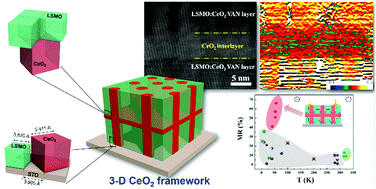Three-dimensional strain engineering in epitaxial vertically aligned nanocomposite thin films with tunable magnetotransport properties
Xing Sun, Jijie Huang, Jie Jian, Meng Fan, Han Wang, Qiang Li, Judith L. Mac Manus-Driscoll, Ping Lu, Xinghang Zhang, Haiyan Wang
Index: 10.1039/C8MH00216A
Full Text: HTML
Abstract

Three-dimensional (3D) frameworks have been successfully constructed by interlayering La0.7Sr0.3MnO3 (LSMO)–CeO2 based epitaxial vertically aligned nanocomposite (VAN) thin films with pure CeO2 (or LSMO) layers. Such 3D interconnected CeO2 scaffolds integrate the lateral film strain by the interlayers with the vertical strain in VAN layers, and thus achieve the maximized strain tuning in LSMO. More importantly, by varying the types of the interlayers (i.e., CeO2 or LSMO) and the number of interlayers from 1 to 3 layers, such 3D framework nanostructures effectively tune the electrical transport properties of LSMO, e.g., from a 3D insulating CeO2 framework with integrated magnetic tunnel junction structures, to a 3D conducting LSMO framework, where the magnetoresistance (MR) peak values have been tuned systematically to a record high of 66% at 56 K and enhanced MR properties at high temperatures above room temperature (∼325 K). This new 3D framed design provides a novel approach in maximizing film strain, enhancing strain-driven functionalities, and manipulating the electrical transport properties effectively.
|
Photochemical Ligation Meets Nanocellulose: A Versatile Plat...
2018-04-07 [10.1039/C8MH00241J] |
|
Metal-Organic Framework-Derived One-Dimensional Porous or Ho...
2018-04-03 [10.1039/C8MH00133B] |
|
Correction: Recent advances in air electrodes for Zn–air bat...
2018-03-29 [10.1039/C8MH90010H] |
|
Polymorphism controls the degree of charge transfer in a mol...
2018-03-26 [10.1039/C8MH00223A] |
|
Pseudocapacitance contribution in boron-doped graphite sheet...
2018-03-23 [10.1039/C8MH00156A] |